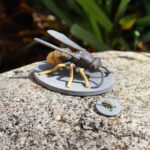Influenced by the distinctive painting techniques of Jackson Pollock, researchers at Harvard’s School of Engineering and Applied Sciences (SEAS) have developed a novel 3D printing approach.
L. Mahadevan, a leading professor at SEAS, wanted to replicate and understand the principles behind Pollock’s unique style. Combining physics and machine learning, his team devised a 3D printing method that leverages natural fluid instability, similar to Pollock’s technique, to swiftly produce intricate physical patterns.

Traditional 3D and 4D printing techniques keep the nozzle close to the surface, which prevents fluid instabilities. However, Pollock’s renowned drip paintings were created by drizzling paint from above, introducing the element of gravity, which can induce unexpected patterns. This concept, where minor motions can lead to significant paint splatters due to gravitational acceleration, was adopted by Mahadevan’s team. They integrated the physics of fluid coiling with deep reinforcement learning to refine the printing process. By learning from previous iterations, the model’s accuracy enhanced progressively.
Video
Utilizing this method, the team replicated Pollock-like patterns and even decorated a cookie with syrup. Although the study employed basic fluids, the potential exists to incorporate complex liquids like liquid polymers or various foods.
You can read the research paper, titled “Learning to write with the fluid rope trick” in the Soft Matter journal at this link.
Come and let us know your thoughts on our Facebook, Twitter, and LinkedIn pages, and don’t forget to sign up for our weekly additive manufacturing newsletter to get all the latest stories delivered right to your inbox.










